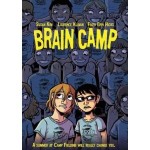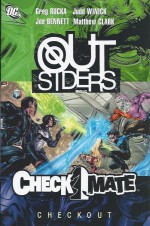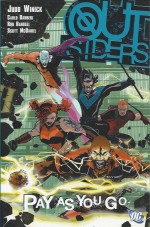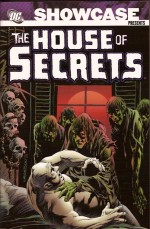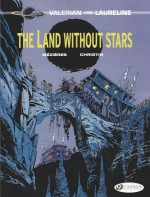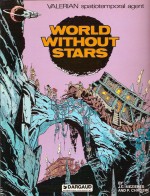
By Joe Quesada, Josh Middleton, Robert Teranishi, Nelson & Chris Sotomayor (Marvel)
ISBN: 978-0-7851-1243-3
Not all Mutants in the Marvel Universe are found and mentored by heroes, villain or the ever-vigilant Federal Government. Some are just left to fend for themselves in a harsh and unforgiving world. That was the premise of an edgy but ill-starred seven issue X-Men spin-off created by scripter Joe Quesada and artists Josh Middleton & Robert Teranishi between 2003 and 2005: a much delayed and deadline-doomed saga which also introduced Wolverine’s “daughter†X-23 (originally an animation character) to the comic book continuity as part of a pack of homeless runaway mutant teenagers.
NYX: (New York: district X) Wannabe follows the troubled life of Kiden Nixon, who we first see as an innocent ordinary toddler witnessing her adored cop father gunned down in the streets. A decade later she is a very troubled bad-girl constantly battling her mom, her skeevy ratbag younger brother and everybody else; perpetually in trouble at school and just not giving a damn.
When she gets into a faceoff with juvenile gangbanger Hector Morales the violence and potential tragedy is only averted by teacher Cameron Palmer, who is pitifully unaware of how deep the animosities run…
When Hector attacks Kiden’s only friend Kara, the emotionally troubled but fiercely protective Nixon girl lashes out and an unsuspected power kicks in for the first time, leaving Morales with a shattered arm and Kiden horrified at what she might be…
If Cameron is baffled and traumatized by the bewildering event, Kiden is on the edge of reason and her positively toxic home environment doesn’t help. Waiting for the disciplinary hammer to fall at school and living in the middle of a frustrating and exasperating war between her male siblings and mother almost proves too much for the girl, but there’s worse waiting at Rudolph Giuliani High where the humiliated Hector has smuggled a gun past the metal detectors…
When he shoots at her, Kiden’s time-freezing power spontaneously activates again and she easily disarms the static would-be killer. However when the world moves again she finds that Miss Palmer has been hit by the bullet she had so easily avoided…
Kiden vanished for good that day, and six months later her tormented teacher has gone to pieces. The shock and trauma proving just too much, one typical day Cameron Palmer takes all her meds at once, slits her wrists in the bathtub and lets go of it all, only to be fortuitously found by Kiden Nixon, back from a chronological walkabout that has taken a little while, six months or many years, depending on your perspective…
As Kiden waits by Cameron’s hospital bedside, fending off the cops’ questions with practised maturity, across town a nigh-autistic child-hooker greets an old client with very specialised tastes. This john doesn’t want simple sex from Zebra Daddy‘s star turn, he just wants to be cut; deep and hard and often…
Daddy is the nastiest pimp in the Flatiron district and his clients and contacts are very powerful…
Kiden is avoiding her family and stays with Cameron after her discharge, but cannot get her to accept that her former pupil is a mutant, nor that her being shot was the student’s fault. Still despondent, Palmer threatens to call Child Protective Services unless Kiden goes home…
Nixon has another secret: for ages she has been receiving guidance and messages from the bloody ghost of her dead father, and that night he directs her to a sleazy hotel in the nastiest part of town. Following, Cameron finds Kiden in a room with a bleeding corpse, and an underage girl covered in blood and with claws projecting from the backs of her hands…
In the Bronxhardworking young Tatiana Caban uncomplainingly mixes her part-time jobs with schoolwork, but finds her greatest joy in caring for the veritable colony of stray animals she has gathered in the derelict ruins of the Borough. Meanwhile Cameron, the rescued cutter girl and Kiden sit in a Diner. The teacher is at last listening to her lost former student as the refugee girl describes her runaway months: when she learned how to use her powers, stopping and starting her personal time-line. Despite the obvious pitfalls it wasn’t all bad: avoiding cops, brutes and rapists eventually turned into living wild and free with fellow homeless kids and even finding first love…
Eventually she returned home only to have her brother chase her away without ever seeing their mother or the new family she was marrying into. Sleeping in an ally that night her murdered father came to her and told Kiden to go to her teacher’s apartment…
Tatiana’s home life is no picnic either with her mother preferring the company of bad men to caring for her own kids, but nothing like as bad as the story the hooker – “Jade†-tells Kiden and Cameron about how her latest trick really died. …and then dead Dad appeared again…
With issue #5 of the sporadically released and permanently deadline-missed series, artist Robert Teranishi and inkers Nelson & Chris Sotomayor replaced Josh Middleton, just as a flashback revealed how psychotic pimp Zebra Daddy took the news that a major repeat customer was dead and his best money-maker was in the wind with a couple of stray girls…
In Cameron’s flat, the ghost – who only Kiden can see – is telling her to get out now and only moment’s later Daddy and his crew bursts in, all guns blazing…
Next morning Tatiana’s life changes forever as her mutant power triggers at school. Tragically that “gift†is to become an anthropomorphic form of any animal whose blood she touches – such as that wounded puppy she picked up on the way to class…
Her spectacular public transformation into a dog-faced girl sparks an anti-mutant riot in school and the terrified teen is hounded down Main Street by a crazed mob, until she runs straight into the hiding Kiden and her fugitive friends.
Zebra Daddy is going ballistic. Until the girls are safely disposed of, his business is a liability and potential death sentence, but none of his gang can find Jade or her friends. Lucky for him he knows someone who can help…
Bobby Soul is a mutant too, a guy who can project his consciousness into others and possess them. As “Felonâ€, Bobby was a real asset to Daddy’s business but these days the guy was retired, spending his time looking after his severely mentally challenged and mute little brother. Nonetheless, Bobby could be persuaded to do a favour for an old comrade, especially as the money was so useful and his ex-boss promised nobody was going to get hurt…
Of course Daddy is unaware of the downside of Felon’s gift: all that time spent in other people’s heads meant that Bobby’s own memories were slowly eroding…
Events cascade to a bloody climax once Bobby’s powers ferret out the runaway girls and he passes on the information to ZD. However with his mission accomplished Bobby returns to his radically-impaired dependent and is horrified to see the blood-spattered ghost of a policeman hovering above the somnolent “Lil’ Broâ€â€¦
With the dead white guy giving advice and instructions, Bobby realises how he’s been fooling himself and the errors of his solitary ways before setting off to make amends, well aware of what Zebra Daddy and his goons are really intending to do…
Of course nobody can conceive of what Kiden, Jade and “Catiana†are capable of either…
Dark, harsh and pitilessly gritty this troubled tale of truly troubled teens effectively delves beneath the sordid underbelly of the urban cityscape to deliver a suspenseful, mature blend of mutant mayhem and hard-hitting social drama that will appal some Fights ‘n’ Tights fans but hopefully appeal to readers looking for an edge of tawdry realism in the fantasy fiction.
This collection also includes an exhaustive sketchbook section by Middleton, an examination of the cover creation process, an unused finished cover and extensive pencil art pages to enthral those with a need to know and a desire to make their own graphic epics one day.
© 2003, 2004, 2005 and 2006 Marvel Characters Inc. All Rights Reserved.

